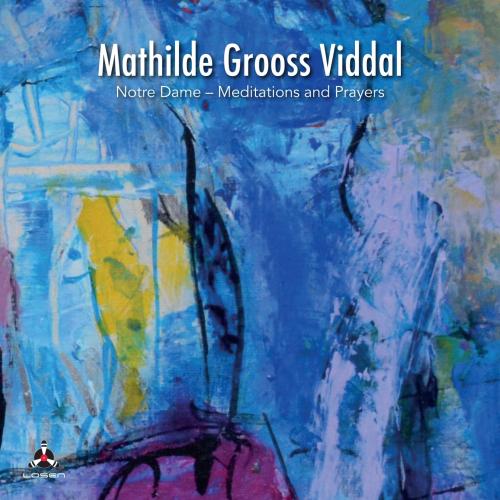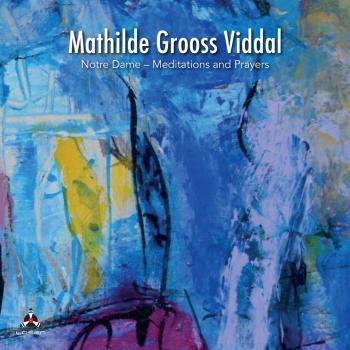
Notre Dame - Meditations and Prayers Mathilde Grooss Viddal
Album info
Album-Release:
2020
HRA-Release:
26.11.2020
Album including Album cover
- 1 Notre Dame 01:48
- 2 Reflection I 04:11
- 3 Psalm 1 01:38
- 4 Reflection II 06:18
- 5 Psalm 2 01:15
- 6 Reflection III 02:58
- 7 Du som låg i natti seine 01:23
- 8 Reflection IV 04:29
- 9 Meditation 04:35
- 10 Reflection V - Psalm 3 05:20
- 11 The Boys Lament for his Dragon 03:21
- 12 Afterthought 03:14
- 13 Prayer 06:10
Info for Notre Dame - Meditations and Prayers
Listening to Mathilde Grooss Viddal’s Meditations and Prayers, the listener may well feel there is a timeless quality to the music. The majority of the tracks are entitled “Reflection” and “Psalm,” and these two dimensions come together on “Reflection V – Psalm 3.” These references to meditation and afterthought are also explorations of musical material, some of which has its origin centuries ago. The musicians explore this material in a soft-spoken, but at the same time intense, manner. Soft-spoken is obviously not quite the right term, as there is no speech here, although there is communication. The musical voices establish something deeply meaningful. And I can only guess that those listeners who recognize the songs used, will relate the meanings of the music with the non-heard lyrics of tradition.
That the source-material is, so to speak, hidden in the music, makes sense in this context. The hymns and folk-songs, be it “Ingen vinner frem til den evige ro,” “Det hev ei rose sprunge” (Es ist ein Ros entsprungen), “Om kvelden når det mørkner,” “Jeg råde vil alle i ungdommens dage,” or “O bli hos meg” (Abide with Me), are not here as singular compositions, but as traces of the past, as a sonic archive being reenacted, showing how the past is with us, how heritage is part of who we are, and how contemplating the past – making connections with the past – is not about striving towards something timeless, but about acting in the here and now, using the past to inform our present.
Much of the album was recorded in the legendary Rainbow Studio in Oslo in collaboration with Jan Erik Kongshaug. The framing of the album, however, was recorded in Færvik kirke, a wooden church on the island of Tromøya, where Viddal’s foremothers where waiting for heir husbands, sons, and brothers to come home from the sea. In many ways, the album feels like one long sermon, where different nuances of thought are hinted at, giving ample room for the listener to sink back into her own thoughts and reactions. Here, too, the echo of tradition gives depth to a feeling of timelessness, of being connected to foremothers and forefathers, of listening to history and tradition.
There is a long tradition of relating breath with spirit or soul in Greek “pneuma” and Hebrew “ruach.” Given this tradition, it makes sense listening to wind instruments (both woodwinds and brass), as in a particular way related to the human condition, as a way of giving sound to our basic humanness, breathing soul into the world. On this album, the instruments are affirming a core of human existence, giving us as listeners space to listen and mediate on our place in the world, a place where the echoes of past days are still here, and can be heard at each and every reiterations of a music with a long history, a music that in one sense is old, but in another sense is always also current.
Mathilde Grooss Viddal, bass clarinet, soprano saxophone, tenor saxophone
Hayden Powell, trumpet
Børge-Are Halvorsen, tenor saxophone
Øyvind Brække, trombone
Per Willy Aaserud, trumpet & electronics (tracks 1, 7, 13)
Mathilde Grooss Viddal
is an artist with deep foundation in several different styles, whose own work goes beyond the boundaries of genre. She has received several International Awards for Composition/Arrangement and released 5 CDs with her orchestra – FriEnsemblet – to great critical acclaim amongst reviewers of jazz in Norway and internationally. She has performed with several different bands and orchestras in Norway and abroad and collaborated with musicians from all over the world, in recent years in close collaboration with the French-Syrian musician Naïssam Jalal.
Her latest commissioning was an arrangement written for Symphony Orchestra and Langeleik (among the oldest instruments in Norway) and was performed with the Norwegian Radio Orchestra (KORK) at ULTIMA 2019.
Viddal has “gradually created a name as one of Scandinavia’s great creators of free and contemporary jazz” (Tina Paulsen Christensen/Jazz Special, Denmark), contributed to dozens of CD releases, and received several commissions and installations at home and abroad. She has just finished the commissioning “Tri vendur blés ho i den høgaste sky” which was performed at Vossajazz in 2018 and performed at the opening of UNESCO’s European Cultural Heritage 2018 and at UNESCO International Jazz Day(s) 2018, Molde International Jazzfestival 2019, Hemnesjazz 2019 and Riksscenen 2019. Viddal has received the title of residerende kapellmester (res.kamp.) at Kampenjazz in Oslo in 2016.
In 2018 ble hun en av 10 vinnere som mottok den internasjonale prisen; Global Women in Music for Human Rights/Donne in Musica, i forbindelse med FNs 70års jubileum av signeringen av Menneskerettighetserklæringen – Prisen ble overrakt under en galla konsert i Teatro Argentina i Roma.
Viddal has been a member of the Norsk Komponistforening (Norwegian Composer Association) since 2018. Er varamedlem i styret i 2019/2020.
This album contains no booklet.










